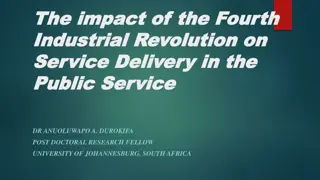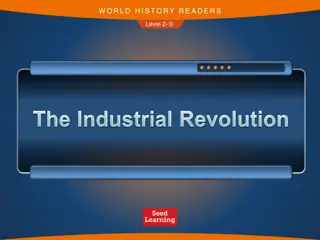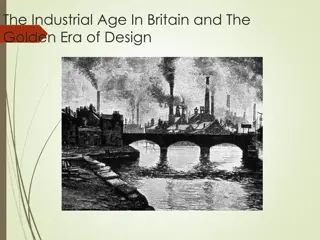The Industrial Revolution: Transforming Society Through Innovation
The Industrial Revolution marked a monumental shift in human history, transitioning from small farming villages to industrialized cities. Originating in Britain, this era saw the rise of machine-made products, improved transportation, and agricultural advancements that fueled industrial growth. As rural lifestyles faded, urban centers emerged, fostering innovation, trade, and societal changes. The integration of new technologies and farming practices reshaped economies and paved the way for a modernized world.
Download Presentation

Please find below an Image/Link to download the presentation.
The content on the website is provided AS IS for your information and personal use only. It may not be sold, licensed, or shared on other websites without obtaining consent from the author. Download presentation by click this link. If you encounter any issues during the download, it is possible that the publisher has removed the file from their server.
E N D
Presentation Transcript
The Industrial Revolution Dawn of the Industrial Age
The Industrial Revolution For thousands of years, most people lived in small farming villages During the mid-1700s, the Industrial Revolution changed the way of life for humanity
The Industrial Revolution The Industrial Revolution began in Britain The Industrial Revolution was a long, slow process in which production shifted from handmade products to machine-made products The Industrial Revolution slowly spread from Britain to the rest of Europe, North America, and around the world
Life Changes as Industry Spreads Prior to 1750, most people worked the land, made their own clothing and grew their own food Most people traveled no farther than the local town to exchange goods With the onset of the Industrial Revolution, rural way of life disappeared, and villages began to grow into industrialized cities where people could buy food and clothing
Life Changes as Industry Spreads New inventions such as the train and steamship allowed travelers and ideas to move rapidly between countries and continents Improved communication and transportation allowed new inventions and scientific discoveries to come out quicker and more efficiently
Agriculture Spurs Industry Agricultural Revolution helped to spur the Industrial Revolution The Dutch led the way in this new Agricultural Revolution, building dikes (reclaim land from the sea), combine smaller fields into larger ones (better use of land) and using fertilizer
Agriculture Spurs Industry In the 1700s, British expanded on Dutch innovations Farm journals allowed exchange of farming methods Farmers tested mixing soils, crop rotation, and planting turnips to restore exhausted soil Jethro Tull invented a machine to deposit seeds in rows rather than scattering them wastefully
The Enclosure Movement Rich landowners pushed ahead with enclosure (the process of taking over and consolidating land formerly shared by peasant farmers) Landowners wanted to create larger fields that could be cultivated more efficiently, supported by British Parliament through legislation
The Enclosure Movement As farms became enclosed, output and profits rose Farmers needed fewer workers Movement did have large human costs Laborers thrown out of work Small farmers forced off land Jobless workers moved to towns and cities, forming a growing labor force that would tend the machines of the Industrial Revolution
Population Multiplies Agricultural Revolution contributed to rapid population growth Agricultural Revolution reduced the risk of death due to famine due to surplus food Better food made people healthier Better hygiene, sanitation, and improved healthcare slowed deaths from disease
New Technology The development of new technology helped trigger the Industrial Revolution New sources of energy and materials helped to change the way manufacturing was accomplished 1712: British inventor Thomas Newcomen developed a steam engine powered by coal
New Technology 1764: James Watt made improvements to the steam engine that eventually became the key power source of the Industrial Revolution In 1709 Abraham Darby began using coal instead of charcoal to smelt iron (the process of separating iron from its ore) Iron became a staple building material for the Industrial Revolution









